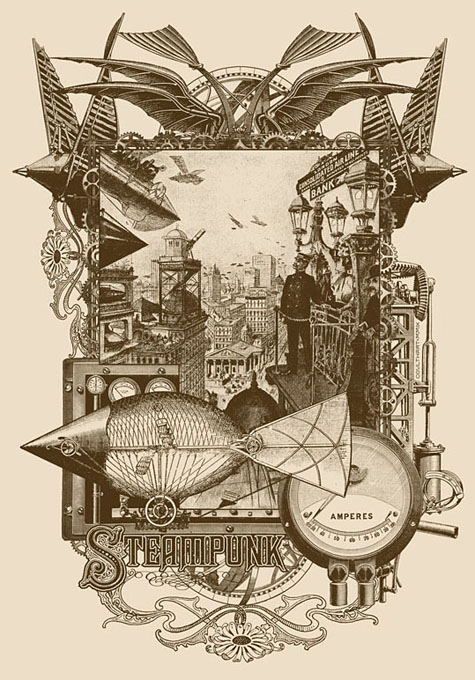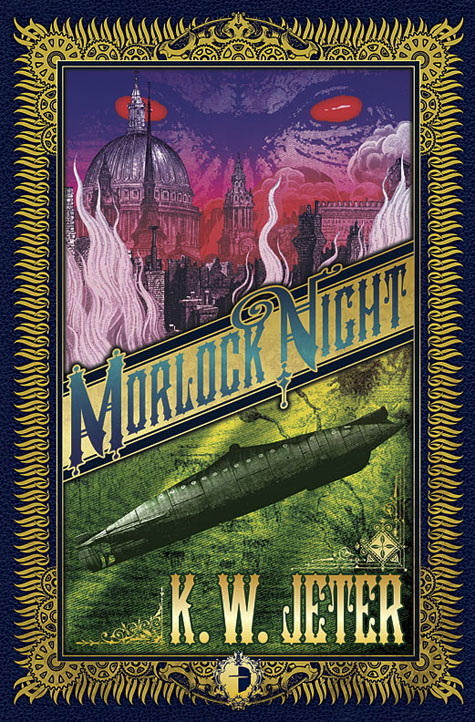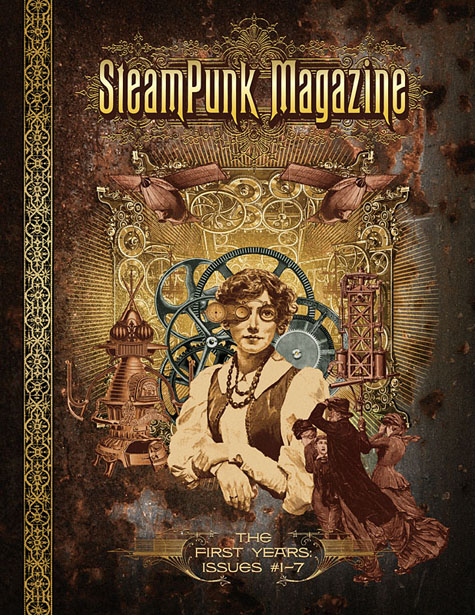Collage is the technique I’ve been using for steampunk pieces and illustrations that I’ve been doing recently. When I used to use pencil, ink, and paint I was seldom attracted to collage despite appreciating what others could do with the technique. Photoshop changed all that, of course, making it easy to replicate and manipulate any available picture.
When it comes to creating faux-Victorian artwork I have a slight advantage in possessing a book collection which includes many titles from the Dover Pictorial Archive series. Also a number of similar archive books from Pepin Press, two huge volumes of engraved art (Images of Architecture and Images of Medicine) collected by collagist Jim Harter (also the compiler of many Dover editions), eleven volumes of Gustave Doré’s engraved illustrations, and even a few genuine 19th century books where the reproductions of wood engraving are always a lot more sharp and detailed than later copies.

I started collecting these books in the late 1980s, partly because I’ve always liked engraved illustrations, but also because they were useful for picture reference when drawing. (Pre-internet any working illustrator needed a library card and a good home collection of reference material.) I also felt some of the books would be useful one day if I ever decided to try emulating the engraving collage style of two favourite artists, Max Ernst and Wilfried Sätty. Ernst was the first person to create memorable collages from Victorian book and magazine art, and it’s a testament to his strength as an artist that one of his collage creations, Une Semaine de Bonté (1934), is also one of the masterworks of Surrealism. Wilfried Sätty was a German artist who moved to San Francisco in the early 1960s and became involved in the psychedelic poster scene a few years later. He developed his own quasi-Surrealist collage style based on Ernst’s technique using engravings from encyclopedias and other books which he also scaled and replicated using a litho printer. I discovered Sätty’s art in an illustrated edition of Poe published in the 1970s, then tracked down the earlier collections of illustrations he produced for Rolling Stone magazine. Sätty has been a big influence on my approach to collaging for the way he evolved from Ernst-like Surrealist juxtaposition to creating coherent scenes from disparate elements. His final book, the posthumously-published Visions of Frisco, was a history of San Francisco whose illustrations are all collages, but which look at a glance like genuine 19th century pictures.

The great thing about engravings is their uniform appearance—black lines on white—which means that isolated images blend together a lot more easily than photograph fragments tend to do. The more photo-real an image is, the more you have to work to fool the brain into accepting that two images placed together are occupying the same pictorial space. Engravings give you that advantage but the challenge then is to create a scene or a design which seems more than the sum of its parts. When you’re restricting yourself to using one particular kind of graphic image in this way it can sometimes take a while to find the precise antique image which suits the composition. This is a limitation but it can also lead to compositions you may not have otherwise developed.
The technique seems an ideal one for steampunk illustration not only because you’re using the actual images and visual motifs of the 19th century, but the early style of collaging known as decoupage was also a popular craft technique in the Victorian era. The Dover and Pepin books have also helped when creating graphic design for steampunk illustrations. I have several collections of border designs, alphabets, ornamental motifs, vignettes and so on, all of which are useful when it comes to piecing together a design which has to resemble a particular period.

Technical aspects aside, the process for me is pretty much the same as doing any other kind of illustration, my principal concern being to create a good composition with a strong central focus. Usually I’ll have a central image in mind; if I don’t then I’ll search for something which would make a good starting point. I seldom sketch anything unless I’m asked to, preferring to work things out as I go along. In the case of the Jeter covers for Angry Robot, I had to submit three different sketches for each cover. Once I have a composition established it’s a case of scanning a lot of material, then spending time chopping out the picture elements from their backgrounds in Photoshop. After that, I work with the black-and-white picture elements until the composition has achieved a satisfactory look before starting to colour everything, usually by building up a series of tinted layers. It can take a while sometimes to get the right colour balance, but Photoshop allows plenty of scope for trying out different variations until you find the look that feels right.
When I saw some of Ernst’s collages in an art exhibition, I was surprised by how small they were; I was used to seeing them reproduced at a much larger size. Ernst had no choice but to work with the scale of the original materials as they were printed. It’s a lot easier doing this digitally than it was in his day.
For more information about Wilfried Sätty, I have a couple of posts on my blog about his work: Wilfried Sätty: Artist of the occult and Illustrating Poe #4: Wilfried Sätty. There’s also a page at Ephemera Assemblyman and a set of Sätty’s illustrations for Dracula at Flickr.
John Coulthart is an illustrator and graphic designer. His collection of Lovecraft comic strip adaptations, The Haunter of the Dark and Other Grotesque Visions, is published by Creation Books.










